 Contributed by Shalin Hai-Jew, Kansas State University
Contributed by Shalin Hai-Jew, Kansas State University
For years now, researchers have harnessed social media data to enhance awareness and to improve work, whether in the public or private sectors. Most of the information used has been direct. The general assumption is that people say what they mean. Some broad and common practices involve the following:
• Capture the messaging around a #hashtag or verbiage, omit the manipulated robot messaging, and you have a sampling of public opinion by conducting a frequency count.
• Map a social network on a social networking site, and get a sense of an individual’s connections and his / her credibility.
• Read the messaging of an individual or group, and through a psycholinguistic analysis, remote profile the individual or group.
• Scrape a set of imagery, and using computer machine vision and sentiment analysis, analyze those for content and sentiment.
In narrower and more close-in cases, researchers can get more nuanced. They can work with higher levels of abstraction, several steps from the original data, to see what may be discovered there. They can engage much smaller sets of data and can extract insights from digital particulate matter.
One method that is in the “long tail” of social media data analysis involves the uses of related tags networks for light data exploration and inferential analytics. Related tags networks are graphs of co-occurring folk tags that appear together at a certain threshold to describe contents uploaded on content-sharing sites.
The inspiration for the following is drawn from two chapters from Dr. N. Raghavendra Rao’s new book Social Media Listening and Monitoring for Business Applications (2017). The two chapters I would like to discuss are the following: Chapter 11, “Capturing the Gist(s) of Image Sets Associated with Chinese Cities through Related Tags Networks on Flickr®,” and Chapter 13, “Exploring Public Perceptions of Native-born American Emigration Abroad and Renunciation of American Citizenship through Social Media.”
The first provides a method, and the latter provides a general topic, albeit with a light twist, given campaign season.
Harnessing related tags networks from Flickr
What could be learned by extracting related tags networks (with thumbnail images) from Flickr using nine terms (tags) related to citizenship? To see how this might work, first, NodeXL Basic (Network Overview, Discovery and Exploration for Excel), a free add-on to Excel, was downloaded from the Microsoft CodePlex platform (https://nodexl.codeplex.com/). This free add-on is maintained by the Social Media Research Foundation (http://www.smrfoundation.org/). A third-party data importer that enables the capture of related tags networks from Flickr was also downloaded and installed. In the Flickr App Garden (https://www.flickr.com/services/), a verified email was used to acquire a “key” and a “secret” to access the Flickr API (application programming interface) to enable access to some limited data on Flickr.
A list of tags was brainstormed: voter, patriot, citizen, president, candidate, immigrant, citizenship, passport, and flag. The first six related to people’s roles in a country, and the last three refer to nouns related to citizenship. (“Non-citizen” was also brainstormed, but there were no tags for that. “Resident” was run, but the meaning was too diffuse in terms of the extracted tags, so that related tags network was not used.)
The same methods were used for all the related tags networks below, so the main variance would be on the respective contents the networks. Specifically, the related tags networks were all extracted at 1.5 degrees. The networks themselves were depicted using the Fruchterman-Reingold force-based layout algorithm within boxed treemaps. Clusters were extracted using the Clauset-Newman-Moore layout
algorithm. The graphs should generally show the co-occurring tags with the seed tag but also how the respective tags cluster by relatedness or similarity. The tags are “folk” ones, applied by non-professionals, who are sharing their photos and videos with those in their social networks as well as those in wider global communities.
While the thumbnail images related to each tag are shown, it is important to note that the imagery do not vary. A certain thumbnail is linked to a particular tag over time, and there is not available documentation that explains if those images were randomly selected from a set of uploaded images using that tag, or if there was some human oversight in the selection of the tags, or some mix of methods. (If this author were to guess, she would guess that there was a cyborg method in selecting the images because sometimes the images make sense, but other times, the images do not make human sense.)
Some extracted citizenship-based related tags networks from Flickr
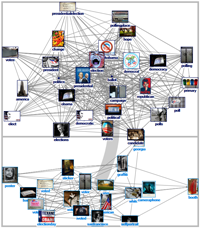 Figure 1: “Voter” Related Tags Network on Flickr (1.5 deg.) Figure 1: “Voter” Related Tags Network on Flickr (1.5 deg.) | Figure 1 shows a related tags network seeded by the term “voter.” This graph has 45 vertices (nodes), connected by 795 unique edges (links). This network had two clusters (groups) of tags that were more closely interrelated based on some similarity measure. The top cluster seems to be more general, and the one below seems more based on geographical locations. As a 1.5-degree network, this graph has a diameter of two, which means that any two nodes farthest from each other in this network is only two hops away. The graph density of this network is 0.40, and the average geodesic distance is 1.38. Some of these nodes suggest political leanings.
 Figure 2: “Patriot” Related Tags Network on Flickr (1.5 deg.) Figure 2: “Patriot” Related Tags Network on Flickr (1.5 deg.) |
The next graph is seeded by the “patriot” tag (
Figure 2). This tag network graph contains 48 vertices and 816 unique edges. The graph density is 0.36. The average geodesic distance is 1.37. The tags refer to some symbols of patriotism, important dates (fourthofjuly), some landmarks, and military service. Related tags from an image-sharing site, like Flickr (which now also accepts videos), suggests that tags have to point to objects with some materiality. That said, some abstract concepts can instantiate in material things.
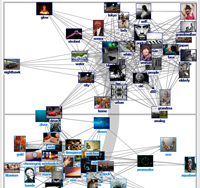 Figure 3: “Citizen” Related Tags Network on Flickr (1.5 deg.) Figure 3: “Citizen” Related Tags Network on Flickr (1.5 deg.) | Figure 3, seeded with the “citizen” tag, seems to draw more from “senior citizen” (top cluster) and from Citizen watches (bottom
cluster). Tags, like semantic bearing terms, are polysemic. The originating context of the imagery and the mental concept of the social media content sharer often inform the tagging. This related tags network contains 61 vertices and 914 unique edges. The graph density is 0.25, and the average geodesic distance is 1.55. This related tags network might suggest that the sense of citizenship that is more directly relevant to the sharers on Flickr are that of senior citizens and Citizen watches than national citizenship (at least for this particular content-sharing platform.
 Figure 4: “President” Related Tags Network on Flickr (1.5 deg.) Figure 4: “President” Related Tags Network on Flickr (1.5 deg.) | Figure 4 was seeded with “president.” This tag set seems highly U.S.-centric (vs. global) and highly focused on national-level presidency (vs. corporate or other types of presidencies). This related tags network contains 51 vertices and 907 unique edges. The average geodesic distance of this graph is 1.47. The graph density is 0.36. Two clusters were extracted. One of the tags has an inspiring
message: yeswecan.
 Figure 5: “Candidate” Related Tags Network on Flickr (1.5 deg.) Figure 5: “Candidate” Related Tags Network on Flickr (1.5 deg.) |
The related tags network in
Figure 5 was seeded with “candidate.” This graph shows a truism about related tags networks on large content-sharing sites. These networks evolve very slowly. It is possible to capture such related tags networks multiple times over several years and find very little change. This is in part because the sizes of the collections are so large that emergent networks tend to achieve a kind of stability or equilibrium that holds over time (the threshold is too high for new tags to break into the relatedness of collections that have stabilized). By comparison, #hashtag networks on trending issues are so dynamic that one can see these changing many times in a second.
This “candidate” related tags network contains 28 vertices with 509 unique edges. The average geodesic distance of this graph is 1.09, and the graph density is .673. (This network has fewer nodes than usual, and the ties are denser.) People’s well defined senses of visual processing enable this understanding even if the graph metrics were not so readily available in NodeXL Basic.
 Figure 6: “Immigrant” Related Tags Network on Flickr (1.5 deg.) Figure 6: “Immigrant” Related Tags Network on Flickr (1.5 deg.) | Figure 6 is a related tags network from “immigrant.” This graph contains 50 vertices and 625 unique edges. The average geodesic distance is 1.54, and the graph density is 0.26. The coverage from these tags seems to show a fairly global listing of concepts, which may suggest more international underlying image holdings in Flickr.
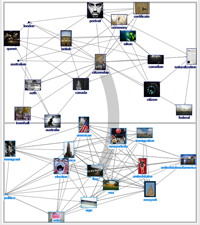 Figure 7: “Citizenship” Related Tags Network on Flickr (1.5 deg.) Figure 7: “Citizenship” Related Tags Network on Flickr (1.5 deg.) |
In the next section,
Figures 7 – 9, there are three seeding terms related to citizenship but which are not human role based: citizenship, passport, and flag.
The “citizenship” related tags network graph is also fairly global, but one of the two clusters does seem to be U.S.-based. This related tags network consists of 31 vertices and 184 edges, with an average geodesic distance of 1.61 and a graph density of 0.198. The higher the graph density, the more connections there are among the tags; the lower the graph density, the fewer the connections between the respective tags.
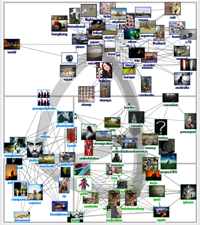 Figure 8: “Passport” Related Tags Network on Flickr (1.5 deg.) Figure 8: “Passport” Related Tags Network on Flickr (1.5 deg.) | In
Figure 8, “passport” was used to seed the related tags network. This network is comprised of 82 vertices and 682 edges.
The average geodesic distance is 1.8, and the graph density is 0.10. This related tags network contains four clusters. The clusters show some geographical leanings, evoking North America, Europe, North Africa, and the Far East.
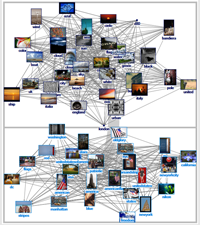 Figure 9: “Flag” Related Tags Network on Flickr (1.5 deg.) Figure 9: “Flag” Related Tags Network on Flickr (1.5 deg.) | Figure 9 was seeded using “flag” as the main tag. This related tags network contains 58 vertices and 1201 unique edges. The average geodesic distance is 1.39, and the graph density is 0.36. This graph contains two clusters. The interplay between the tag concepts and the images shows some embedded meanings, with one appearing to focus more on international flags and another on U.S. ones (and “oldglory”).
 Figure 10: Feature Comparisons across the Related Tags Networks from Flickr Figure 10: Feature Comparisons across the Related Tags Networks from Flickr |
Finally, it is possible to use some of the metrics in a comparative way across the respective related tags networks (
Figure 10). What may be observed in this stacked bar chart? The “candidate” related tags network has the highest graph density (0.67) which suggests that its tags co-occur with fair regularity and that there is likely reciprocation among the vertices. A perusal of
Figure 5 confirms that there is a high interrelatedness of concepts among the tags. Another observation may be that while “flag” only has 58 nodes, it has 1,201 unique edges, which makes for a fairly dense graph (with high interconnectivity among its tags). On the other extreme, the “passport” related tags network only has a graph density of 0.1, and a perusal of
Figure 8 shows dispersion of meaning among the tags (which can also be seen in the fact that there are four clusters.
Conclusion
Related tags networks may be studied in various ways. They may reveal information such as what meta-level concepts are connected in the public mind (whether at the level of consciousness, sub consciousness, or unconsciousness). These are appealing to look at because they function on cognitive and visual levels. They are suggestive of ideas even if these ideas are not directly spelled out.
Shalin Hai-Jew works as an instructional designer at Kansas State University (K-State) and taught for WashingtonOnline for a number of years through 2014. She has taught at the university and college levels for many years (including four years in the People’s Republic of China) and was tenured at Shoreline Community College but left tenure to pursue instructional design work. She has Bachelor’s degrees in English and psychology, a Master’s degree in Creative Writing from the University of Washington (Hugh Paradise Scholar), and an Ed.D in Educational Leadership with a focus on public administration from Seattle University (where she was a Morford Scholar). She reviews for
Educause Review Online and is editor of several IGI Global titles. Dr. Hai-Jew was born in Huntsville, Alabama, in the U.S.